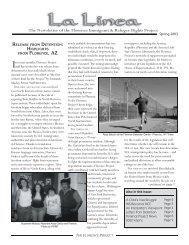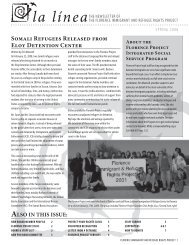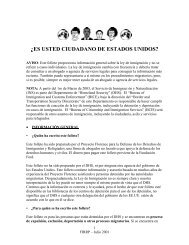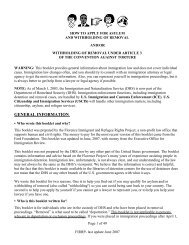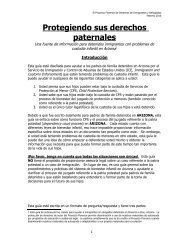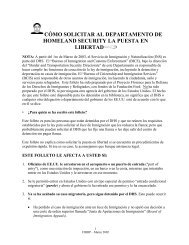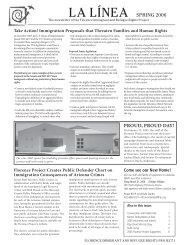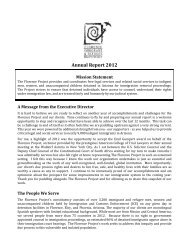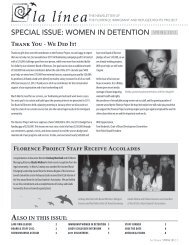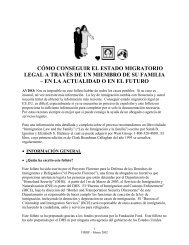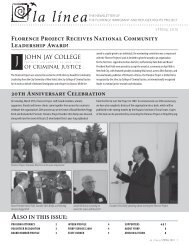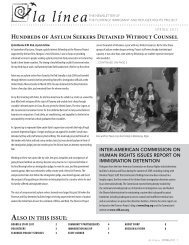quick reference chart and annotations for determining immigration ...
quick reference chart and annotations for determining immigration ...
quick reference chart and annotations for determining immigration ...
You also want an ePaper? Increase the reach of your titles
YUMPU automatically turns print PDFs into web optimized ePapers that Google loves.
Immigrant Legal Resource Center, Florence Immigrant <strong>and</strong> Refugee Rights Project,<br />
Maricopa County Public Defender August 2012<br />
Escape in the second degree, § 13-2503<br />
A. A person commits escape in the second degree by knowingly:<br />
1. Escaping or attempting to escape from a juvenile secure care facility, a juvenile detention facility or an<br />
adult correctional facility; or<br />
2. Escaping or attempting to escape from custody imposed as a result of having been arrested <strong>for</strong>, charged<br />
with or found guilty of a felony; or<br />
3. Escaping or attempting to escape from the Arizona state hospital if the person was committed to the<br />
hospital <strong>for</strong> treatment pursuant to section 8-291.09, 13-502, 13-3994, 13-4507, 13-4512 or 31-226, title<br />
36, chapter 37 or rule 11 of the Arizona rules of criminal procedure.<br />
Escape in the first degree, § 13-2504<br />
A. A person commits escape in the first degree by knowingly escaping or attempting to escape from<br />
custody or a juvenile secure care facility, juvenile detention facility or an adult correctional facility by:<br />
1. Using or threatening the use of physical <strong>for</strong>ce against another person; or<br />
2. Using or threatening to use a deadly weapon or dangerous instrument against another person.<br />
Crime Involving Moral Turpitude (CMT): While §§ 13-2502 <strong>and</strong> 13-2503 are likely not<br />
CMT’s, § 13-2504 is probably a CMT due to the use or threatened use of <strong>for</strong>ce. See Matter of M, 2 I&N<br />
Dec. 871 (BIA 1947) (conviction of breaking prison does not involve moral turpitude since it does not<br />
require the element of <strong>for</strong>ce or fraud); Matter of Z, 1 I&N Dec. 235 (BIA 1942) (prison breach does not<br />
involve moral turpitude since the offense did not require <strong>for</strong>ce or fraud as an essential element).<br />
Aggravated Felony: Escape in the second degree could potentially be charged as an aggravated<br />
felony under 8 U.S.C. § 1101(a)(43)(S) as an offense relating to obstruction of justice <strong>for</strong> which the<br />
sentence imposed is one year or more. Escape in the first degree could be charged as obstruction of<br />
justice or under 8 U.S.C. § 1101(a)(43)(F) as a crime of violence <strong>for</strong> which the sentence imposed is one<br />
year or more.<br />
As obstruction of justice: If possible, obtain a sentence of 364 days or less. The Ninth Circuit<br />
has held that escape from custody that occurs either be<strong>for</strong>e or after the initiation of judicial proceedings<br />
does not meet the definition of obstruction of justice. Salazar-Luviano v. Mukasey, 551 F.3d 857, 862-63<br />
(9th Cir. 2008). Many convictions under this statute occur as a result of defendants who are sentenced to<br />
a work release program <strong>and</strong> fail to appear, which should not qualify as obstruction of justice since no<br />
pending judicial proceedings existed at the time of the offense. But the BIA has recently broadened the<br />
definition of obstruction of justice to include “an affirmative <strong>and</strong> intentional attempt, motivated by a<br />
specific intent, to interfere with the process of justice, irrespective of the existence of an ongoing<br />
criminal investigation or proceeding.” Matter of Valenzuela-Gallardo, 25 I&N Dec. 838 (BIA 2012). In<br />
light of the BIA’s exp<strong>and</strong>ed definition, counsel should assume that a conviction with a one-year sentence<br />
will be found an aggravated felony.<br />
As a crime of violence: Escape in the third or second degree would not meet the definition of a<br />
“crime of violence.” However, the element of “using or threatening to use” physical <strong>for</strong>ce, a deadly<br />
weapon, or a dangerous instrument would make conviction <strong>for</strong> first degree Escape a “crime of violence”<br />
pursuant to 18 U.S.C. §16 if a sentence of one year or more is imposed. Counsel should try to plead to<br />
second or third degree Escape <strong>and</strong>/or secure a sentence of 364 days or less.<br />
58. Failure to Appear, ARS §13-2506-7<br />
Arizona Criminal Chart with Explanatory Endnote – August 2012<br />
70



